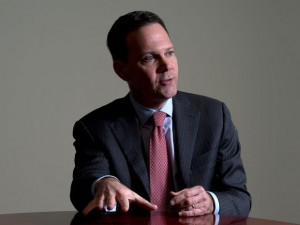
Exchange-traded funds (ETFs) have revolutionized the way investors access the stock market. Since the global bond market is much larger than the equity market, it stands to reason that bond ETFs should experience equal popularity with retail and institutional investors.
Friday morning, BlackRock Canada held a briefing session on exactly this topic. Warren Collier, head of iShares Canada, likened the current juncture for bond ETFs to where equity ETFs were when he joined the firm in 1999.
“Before XIU [iShares i60s, one of the largest Canadian equity ETFs] TIPS [Toronto Index Participation Units] had been out for a few years; there was an understanding of what equity ETFs were but it was not very deep. They were used by insttitutional and direct retail investors and advisers were starting to ask questions about them. The conversations today about fixed-income ETFs reminds me of those conversations.”
Still, compared to equity ETF penetration globally, fixed-income ETF market penetration is still relatively low. Equity ETFs make up 3% of the global equity market. Even though the fixed-income market overall is larger, fixed-income ETFs make up only 0.4% of the global fixed-income market, Collier said.
“So globally we’re still very early. There’s an incredible amount of growth left for Fixed Income ETFs globally.”
Generally, iShares executives downplayed the risk to bond investors of interest rates going higher by the end of the year, which seems to be the consensus about when the Fed will finally start hiking rates. Still, they agreed retail investors increasingly are looking for help in worrying about what fixed-income products are appropriate in this environment.
Moving from Building Blocks to Solutions
In this regard, fixed-income ETFs are poised to follow the trend in equity ETFs from being mere building blocks for portfolios to offering solutions to the actual needs of investors and their financial advisors. Investors need help finding adequate income in an era of financial repression from the world’s central banks, but they don’t want to suffer capital losses by going too far out in maturities with the US federal reserve clearly poised to finally raise interest rates for the first time since the financial crisis.
They may attempt to reach for yield by picking long-term bond funds but that exposes capital to potential loss if rates soar. They can go the high-yield or junk-bond market but be exposed to credit risk. Or they can go to international bond markets where rates are already higher, but that entails taking on more currency risk.
Instead of forcing investors and/or advisors to choose from a variety of fixed-income ETFs, it makes sense to provide a strategic portfolio where this decision is made by the experts. Indeed, earlier this year Black Rock Canada unveiled just this: a strategic fixed-income suite of products. One of them, the iShares Short Term Strategic Fixed Income ETF (ticker XSI/TSX) has sold $220 million since its launch in January 2015, making it one of the firm’s biggest sellers. Management fee is 0.5%, distribution yield is 3.79%, duration is 3.63 years and weighted average maturity 5.58 years.
It’s actually a fund of funds: as of mid-year, 30% was in the iShares Floating Rate Index ETF, 29% the iShares Canadian HYBrid Corporate, 27% iShares US High Yield Bond index, plus smaller positions in three other bond ETFs and some cash. Foreign currency exposure is hedged back into the Canadian dollar.
In September, iShares unveiled its Conservative Strategic Fixed Income ETF (ticker XSE, TSX) and Conservative Short Term Strategic Fixed Income ETF (XSC, TSX). Both take a similar fund of fund approach: XSC has 39% exposure to US debt and another 18.5% to Emerging Market debt, and the fund has exposure to all maturities and credit quality.

